Initially, Lincoln Cents, also known as Lincoln Pennies, were referred to as Wheat Cents because they featured two stalks of wheat on the reverse. However, from 1958 to 2008, the reverse design changed to display the Lincoln Memorial Building in honor of Abraham Lincoln’s sesquicentennial—the 150th anniversary of his birth.
Let’s now take a closer look at the 1970 Penny Value, since it was part of the Lincoln Memorial series.
1970 Penny Value Chart
| Coin | MS 63 | MS 64 | MS 65+ | MS 67 | MS 67+ | PR 69 DCAM |
|---|---|---|---|---|---|---|
| 1970 (P) No Mint Mark Penny | $8 | $12 | $20 | $190 | $5,500 | – |
| 1970-D Penny | $10 | $16 | $26 | $500 | $3,500 | – |
| 1970-S Small-Date Penny | $50 | $60 | $110 | $750 | – | – |
| 1970-S Large-Date Penny | $12 | $16 | $26 | $275 | $2,000 | – |
| 1970-S Proof Small-Date Penny | – | – | – | – | – | $9,500 |
| 1970-S Proof Large-Date Penny | – | – | – | – | – | $775 |
History of the 1970 Penny

Abraham Lincoln was the first U.S. President to be honored on a circulating coin. It’s also the longest-running U.S. coin, having been minted every year from 1909 to the present. These days, pennies cost more to produce than their face value—almost 3¢ to mint one in 2023. Despite this loss, they remain popular and iconic, so production continues.
Let’s talk about the 1970 Penny in particular. It belongs to the Lincoln Memorial series, which started in 1959 to mark 150 years since Lincoln’s birth. The coin kept the original obverse (heads side) designed by Victor David Brenner, while the reverse (tails side) was designed by Chief Mint Engraver Frank Gasparro.
Gasparro had to compete against six other engravers to design this iconic reverse. Despite never having seen the Lincoln Memorial in person, his design won. Interestingly, he chose to use a smaller “O” in “UNITED STATES OF AMERICA”, a detail applied throughout the series. There’s no official explanation for this stylistic choice.
Regarding the Small-Date and Large-Date varieties, only one other year, 1960, featured these types. However, San Francisco did not mint coins in 1960—the mint was closed from 1955 to 1965. During that time, proof pennies were struck in Philadelphia. In 1960, both Small and Large-Date coins were minted in Philadelphia and Denver, including both proofs and business strikes.
Features of the 1970 Penny
You can describe the features of the 1970 Penny using ordinary language, but it helps to understand the technical terms so you can better navigate numismatic resources. The heads side is called the obverse, while the tails side is the reverse. The thin outer part of the coin is the edge. The words on the coin are referred to as mottos or legends, and the images or portraits are called devices. The flat background behind the design is the field, and the raised outer rim is known as the collar.
The Obverse of the 1970 Penny
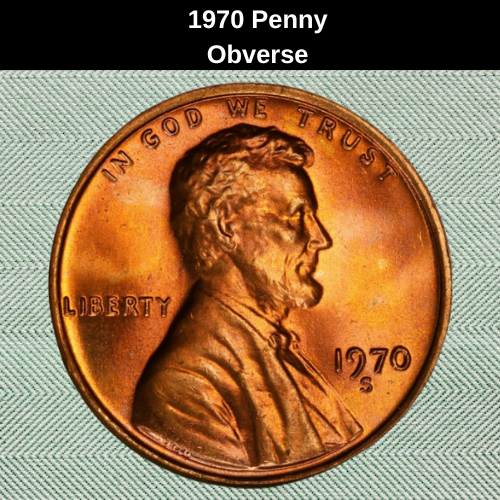
It shows Abraham Lincoln facing right, with “In God We Trust” above his head and “Liberty” on the left, behind his neck. On the lower right of the coin, in front of his chest, you’ll find the date and mint mark. The initials “VDB”, which stand for Victor David Brenner, are located on the shoulder cut-off.
The Reverse of the 1970 Penny
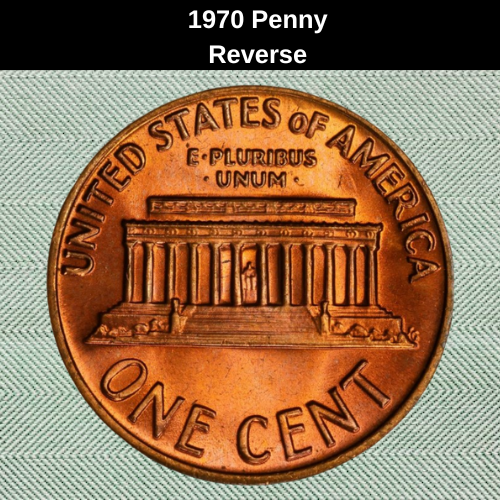
It shows the Lincoln Memorial Building, and you can see Lincoln’s statue through the pillars. The top of the coin reads “United States of America”, with “E Pluribus Unum” directly below. The bottom of the coin reads “One Cent”. The initials “FG”, representing Frank Gasparro, are located at the right corner of the steps.
Other Features of the 1970 Penny
The 1970 Lincoln Memorial Penny is a brass coin made of 95% copper and 5% zinc. The coin weighs 3.11g and is 19.05mm in diameter (0.75”). It has a smooth edge without any reeds. It was the mint’s most profitable coin for centuries, but the price of copper spiked around 1973.
1970 Penny Grading
Wheat Pennies and Memorial Pennies have the same obverse design. But they have different reverse designs, so on the Memorial Lincoln Cent, graders pay extra attention to the steps and the statue. On high-quality coins, you can see Lincoln through the two central columns.
Copper coins are graded RD (red), RB (red-brown), and BN or BRN (brown). Red is the best.
Grading Scale
- 1 – Basal State-1
- 2 – Fair
- 3 – Very Fair
- 4, 5, 6 – Good
- 7, 8, 10 – Very Good
- 12, 15 – Fine
- 20, 30 – Very Fine
- 40 – Extremely Fine
- 50 – About Uncirculated
- 60 – Mint State
- 65 – Mint State
- 70 – Mint State
Please check our grading guides to know your coin scale. It’s the necessary step to know the exact value of your coin.
1970 Penny Value Guides
In 1970, pennies were minted in Philadelphia, Denver, and San Francisco. The San Francisco Mint had four varieties. It made Small Date and Large Date Pennies in both proof strikes (for collectors) and business strikes or regular strikes (for everyday use).
Small-Date Pennies had a Higher “7” while Large-Date Pennies had a Lower “7” in the mint date.
Let’s check them all out.
1970 No Mint Mark Penny Regular Strike Value

In 1970, Pennies coined in Philadelphia had no mint marks. The mint made 1,898,315,000 of them. With so many minted, this coin isn’t especially expensive.
An MS 67+ RD auctioned for $4,406 on 21st March 2014. It’s the highest known grade, estimated at $5,500.
1970-D Penny Regular Strike Value

The Denver Mint coined 2,891,438,900 Memorial Pennies in 1970. They all had the D Mint Mark. The highest grade received by PCGS is MS 67+ RD. It sold for $2,820 on 10th October 2016, but since only four have been submitted, the value estimate is $3,500.
1970-S Small-Date Penny Regular Strike Value
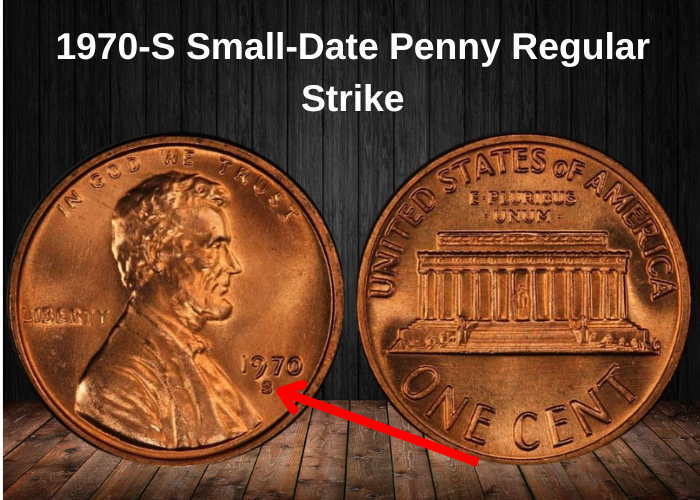
In total, the San Francisco Mint made 690,560,004 Business Strike Pennies. These included both Large-Date and Small-Date Varieties so there isn’t much difference in their pricing. In December 2005, an AU 50 BN sold for $1,610. And in 2008, an MS 67 RD sold for $2,464 in June. It’s the highest known grade but sold for $528 in 2020 and is estimated at $750 today.
1970-S Large-Date Penny Regular Strike Value
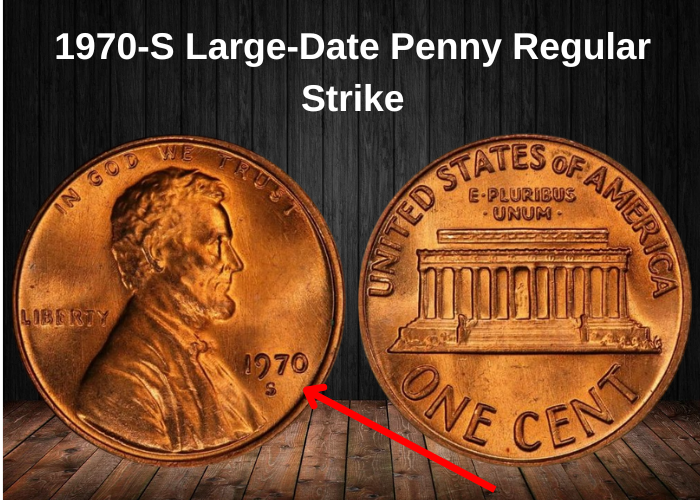
In 2020, an eBay vendor sold an AU 58 BN for $1,000 on 3rd July 2020. Another eBay seller got $1,500 for an MS 67+ RD on 20th February 2020. PCGS has received one MS 68 RD but it hasn’t sold. Their price estimate for an MS 67+ is $2,000. They’ve seen three so far.
1970-S Small-Date Proof Penny Value
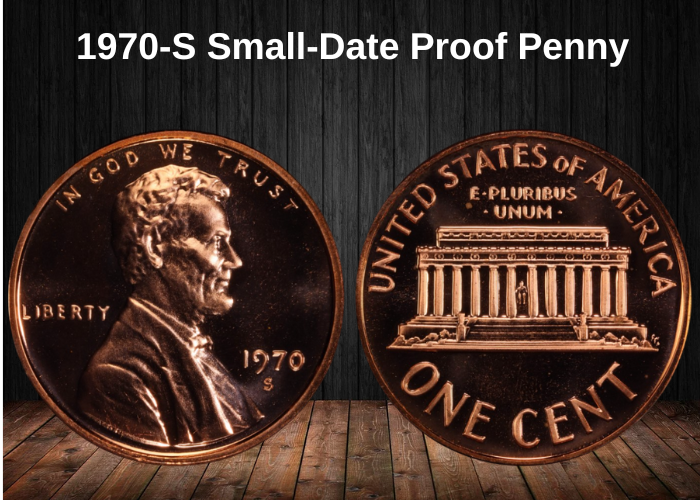
Proof Pennies are made with special dies and planchets. These blanks are burnished before striking to give an extra shine while the dies have a highly polished field and a frosted device for contrast. Coins with the biggest difference between the image and the backdrop get the Deep Cameo or DCAM grade. 1970 was the last year when coins were frosted via acid wash.
The mint made 2,632,810 Small-Date Proof Pennies. On 9th September 2004, a PR 66 sold for $1,323. And on 24th February 2021, a PR 69 CAM was $1,096. But Deep Cameos are so much more valuable. A PR 69 DCAM sold for $18,400 on 1st December 2005. The price has dropped over time though. It was $6,600 in March 2020 but is estimated at $9,500 today.
1970-S Large-Date Proof Penny Value
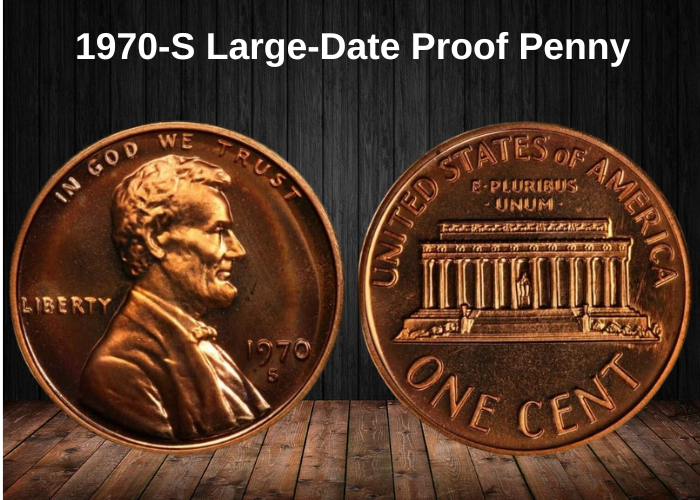
It’s unclear how many Large-Date Proof Pennies were coined in 1970. On 1st May 2003, a PR 70 – the perfect grade – sold for $2,530. But with only four coins submitted to PCGS, their estimate is $1,850. Meanwhile, a PR 69 DCAM sold for $3,220 on 21st November 2021.
Rare 1970 Penny Error List
Lots of people collect pennies because they’re cute and easy to source. But because it’s such a common coin, it’s on the lower end of the price spectrum. Plus, it doesn’t have many mint mistakes. The best known First Strike error is a Doubled Die Obverse. The other 1970 Penny Errors are mostly double denominations, wrong planchets, cud breaks, die clashes, or clips.
1970 (P) Penny Partial Brockage Error
Just because a mint mistake looks dramatic doesn’t necessarily mean it’s valuable. This is a good example. It’s a brockage error, which means the previous coin got stuck on the die, so its reverse struck this coin’s obverse. That distorted the pattern and resulted in a ‘headless’ coin. But as drastic as it is, this NGC-Graded Philadelphia Penny was $65 in MS 60 BRN.
1970-S Proof LD/SD DDO Penny FS-102
DDO means doubled die error. It happens if the die moves between its first and second strike so the second imprint lands slightly to the left or right, creating a double-vision effect. This is then transferred to any coin that die produces. The DDO on the 1970-S is a first strike error.
That means it was spotted within 30 days of release. But the FS-102 is also an overdate error because the Large-Date is struck on top of the Small-Date, and this double-doubled error gives the coin additional value. It sold for $1,290 in PR 66 RD and $1,500 in PR 68 CAM.
1970-S LD DDO Penny Business Strike FS-101
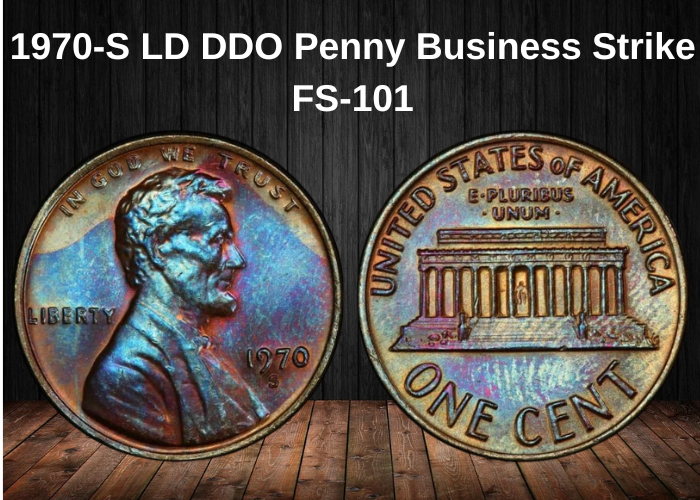
In 1970, the San Francisco Mint made both proof pennies and business strikes. The FS-102 was a proof coin error, while the FS-101 was on both proofs and business strikes. A Brown LD AU 58, the FS-101 DDO, sold for $2,125 in 2010. An LD MS 65 RB DDO was $9,500 in 2018 and $8,225 in 2022, and an LD MS 66 RD was $24,150 in 2001, down to $18,000 in 2022.
1970-S LD TDO Proof Penny FS-107
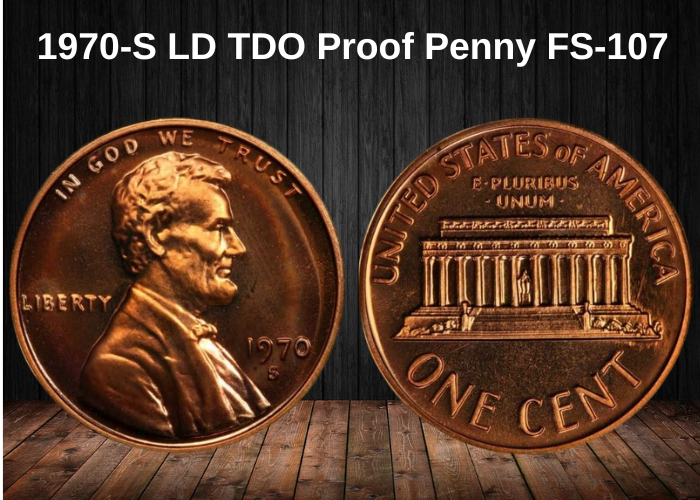
A TDO or Tripled Die Obverse is similar to a DDO, except that the shift happens on both the second and third strikes. This tripling effect is clearest on the words and numbers.
In April 2023, a PR 69 RD Large-Date TDO sold for $1,140. An LD PR 65 CAM sold for half that at $587.50 in July 2013. And an LD PR 67 DCAM went for the same price in October 2016.
1970-S RPM Penny
The 1970-S RPM Penny refers to a Re-punched Mint Mark (RPM). Unlike a DDO (Doubled Die Obverse), which occurs when the die shifts between strikes, RPMs result from manual mistakes during the minting process. Specifically, the mint marks were applied manually to coins before 1990, so when a mint mark was incorrectly placed and then re-punched, it led to this error.
In the case of the 1970-S RPM Penny, the error is easier to spot, as you’ll notice the mint mark appearing more than once—a clear sign of the re-punch. Unlike first strike errors (such as those for DDO), RPM errors on 1970-S proofs are harder to price accurately because there’s more variation in the severity of the error and how much the mint mark was re-punched.
Where to sell your penny?
Now that you know the value of your penny, you might be wondering where to sell it. Don’t worry: here’s a guide to some of the best online platforms where you can easily sell your coins, along with their advantages and disadvantages.
Discover the best platforms for selling coins online (pros and cons).
FAQ About the 1970 Lincoln Penny
1. What makes the 1970 Lincoln Penny historically significant in U.S. coinage?
The 1970 Lincoln Penny is significant in the history of U.S. coinage because it was minted during a period when the U.S. Mint was transitioning to clad coins. By 1970, most coins except for the penny and nickel were already being minted with clad compositions (copper-nickel composition), which were introduced in 1965 to reduce the cost of production. The 1970 penny, however, still retained the 95% copper composition, making it one of the last pennies minted before the 1971 change to clad pennies. This transition marked a major shift in coin production and material costs for the U.S. Mint.
2. What is the mintage of the 1970 Lincoln Penny, and how does it impact its value today?
A total of 3,744,742,000 1970 pennies were minted, split between the Philadelphia and Denver mints. Despite the relatively high mintage, this penny is not especially rare, and its value is mostly tied to its condition rather than rarity. A 1970 penny in circulated condition is worth its face value of one cent. However, it can be worth slightly more in uncirculated condition or if it has been preserved well, especially when compared to other common coins from the era. High-grade examples can be valued between $1 and $5 depending on their condition.
3. Are there any known minting errors for the 1970 Lincoln penny?
Yes, several minting errors are associated with the 1970 penny, some of which are highly sought after by collectors. One of the most notable errors is the 1970-S Small Date. There was a variety in the 1970 penny where the S mintmark (for the San Francisco Mint) appeared smaller than normal on some coins, making this version particularly collectible. The 1970-S Small Date penny is often considered a rarity, and coins in good to excellent condition can fetch a premium price. Additionally, die cracks, double strikes, and off-center strikes are other errors that collectors look for, which can also increase the coin’s value.
4. How does the 1970 Lincoln penny compare to other pennies from the 1970s in terms of collectibility and value?
The 1970 Lincoln penny is relatively common compared to other pennies from the 1970s. However, it stands out due to its copper composition before the transition to clad pennies. As a result, collectors who focus on pre-clad copper pennies may place some interest in the 1970 penny. Coins from the mid-1970s onward, particularly those minted with clad metals, are more common and do not hold the same level of value as the 1970 penny in uncirculated or error-coin conditions. The 1970-S Small Date variety, in particular, stands out as the most valuable and collectible version from this year.
5. How can the 1970 penny be identified as an S Small Date or S Large Date coin?
The 1970-S Small Date and 1970-S Large Date pennies differ primarily in the size of the date on the obverse. The Small Date variety features a smaller, closer-knit number with a more compact look. The Large Date variety, on the other hand, has larger, more spaced-out digits. To identify the Small Date, examine the date on the obverse carefully, especially the “7” and “0”. The Small Date is rarer, and collectors often seek it for its uniqueness, as it was caused by a different die being used during the minting process.
6. What is the value of a 1970 Lincoln penny in uncirculated condition or as a high-grade coin?
A 1970 Lincoln penny in uncirculated condition (with an MS-60 grade or better) can be valued between $1 and $5, depending on its overall quality. If the coin is in pristine, high-grade condition (like MS-65 or better), its value could rise higher, potentially reaching $10 to $20. However, the 1970 penny doesn’t have the same premium value as rarer coins like the 1943 steel penny or 1955 double die penny, so its value remains relatively modest in most cases unless a notable mint error or variation is present.
7. How does the 1970 penny fit into a collection of U.S. coins and the broader Lincoln Memorial series?
The 1970 Lincoln penny holds its place as a part of the Lincoln Memorial series, which ran from 1959 to 2008. For collectors focused on completing sets of the Lincoln Memorial pennies, the 1970 penny is an essential piece, representing the period of coinage before the shift to clad pennies. It also serves as a reminder of the final years of copper pennies before the Mint made the change in 1971. Collectors of this series are particularly interested in the 1970-S Small Date variety due to its rarity and potential value. Additionally, as part of the larger trend of U.S. coinage evolution, the 1970 penny offers a snapshot of mid-20th century U.S. Mint production during a period of economic change.


















































